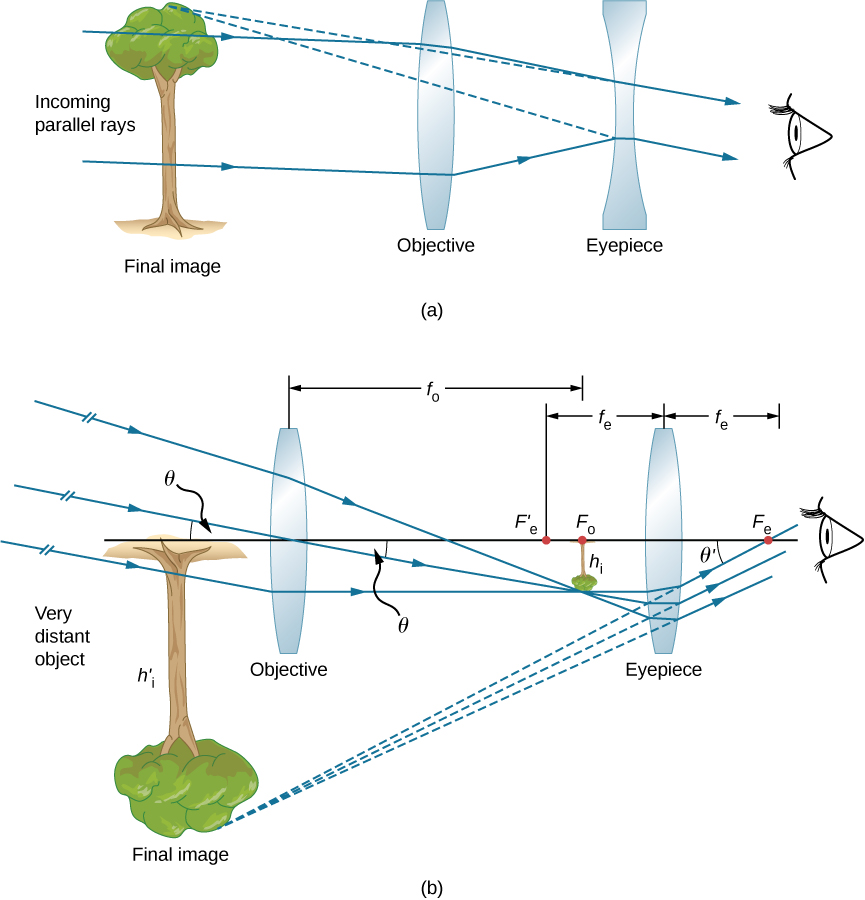| << Chapter < Page | Chapter >> Page > |
We now need to calculate the angular magnification of the eyepiece with the image at infinity. To do so, we take the ratio of the angle subtended by the image to the angle subtended by the object at the near point of the eye (this is the closest that the unaided eye can view the object, and thus this is the position where the object will form the largest image on the retina of the unaided eye). Using [link] and working in the small-angle approximation, we have and , where is the height of the image formed by the objective, which is the object of the eyepiece. Thus, the angular magnification of the eyepiece is
The net magnifying power of the compound microscope with the image at infinity is therefore
The focal distances must be in centimeters. The minus sign indicates that the final image is inverted. Note that the only variables in the equation are the focal distances of the eyepiece and the objective, which makes this equation particularly useful.
Telescopes are meant for viewing distant objects and produce an image that is larger than the image produced in the unaided eye. Telescopes gather far more light than the eye, allowing dim objects to be observed with greater magnification and better resolution. Telescopes were invented around 1600, and Galileo was the first to use them to study the heavens, with monumental consequences. He observed the moons of Jupiter, the craters and mountains on the moon, the details of sunspots, and the fact that the Milky Way is composed of a vast number of individual stars.

Part (a) of [link] shows a refracting telescope made of two lenses. The first lens, called the objective , forms a real image within the focal length of the second lens, which is called the eyepiece . The image of the objective lens serves as the object for the eyepiece, which forms a magnified virtual image that is observed by the eye. This design is what Galileo used to observe the heavens.
Although the arrangement of the lenses in a refracting telescope looks similar to that in a microscope, there are important differences. In a telescope, the real object is far away and the intermediate image is smaller than the object. In a microscope, the real object is very close and the intermediate image is larger than the object. In both the telescope and the microscope, the eyepiece magnifies the intermediate image; in the telescope, however, this is the only magnification.
The most common two-lens telescope is shown in part (b) of the figure. The object is so far from the telescope that it is essentially at infinity compared with the focal lengths of the lenses , so the incoming rays are essentially parallel and focus on the focal plane. Thus, the first image is produced at , as shown in the figure, and is not large compared with what you might see by looking directly at the object. However, the eyepiece of the telescope eyepiece (like the microscope eyepiece) allows you to get nearer than your near point to this first image and so magnifies it (because you are near to it, it subtends a larger angle from your eye and so forms a larger image on your retina). As for a simple magnifier, the angular magnification of a telescope is the ratio of the angle subtended by the image [ in part (b)] to the angle subtended by the real object [ in part (b)]:

Notification Switch
Would you like to follow the 'University physics volume 3' conversation and receive update notifications?